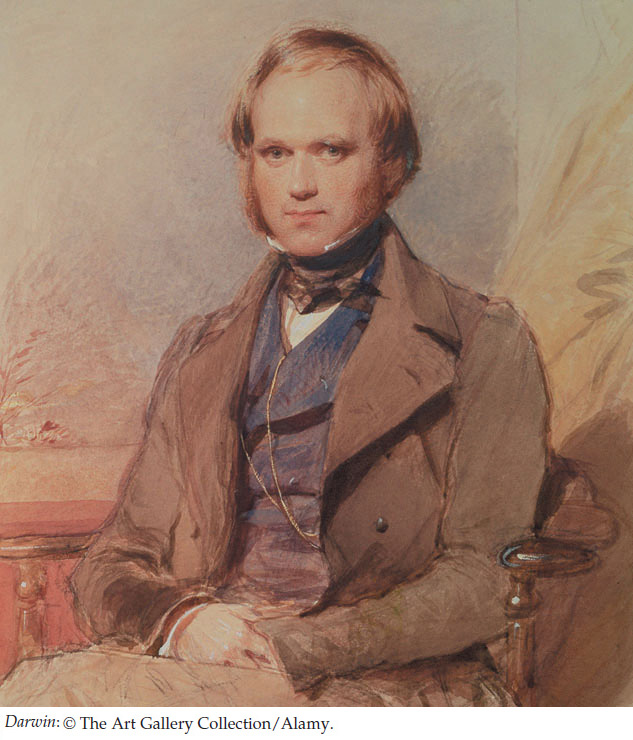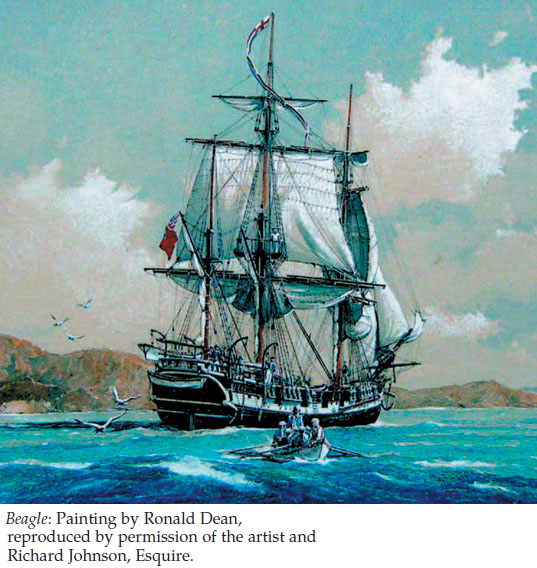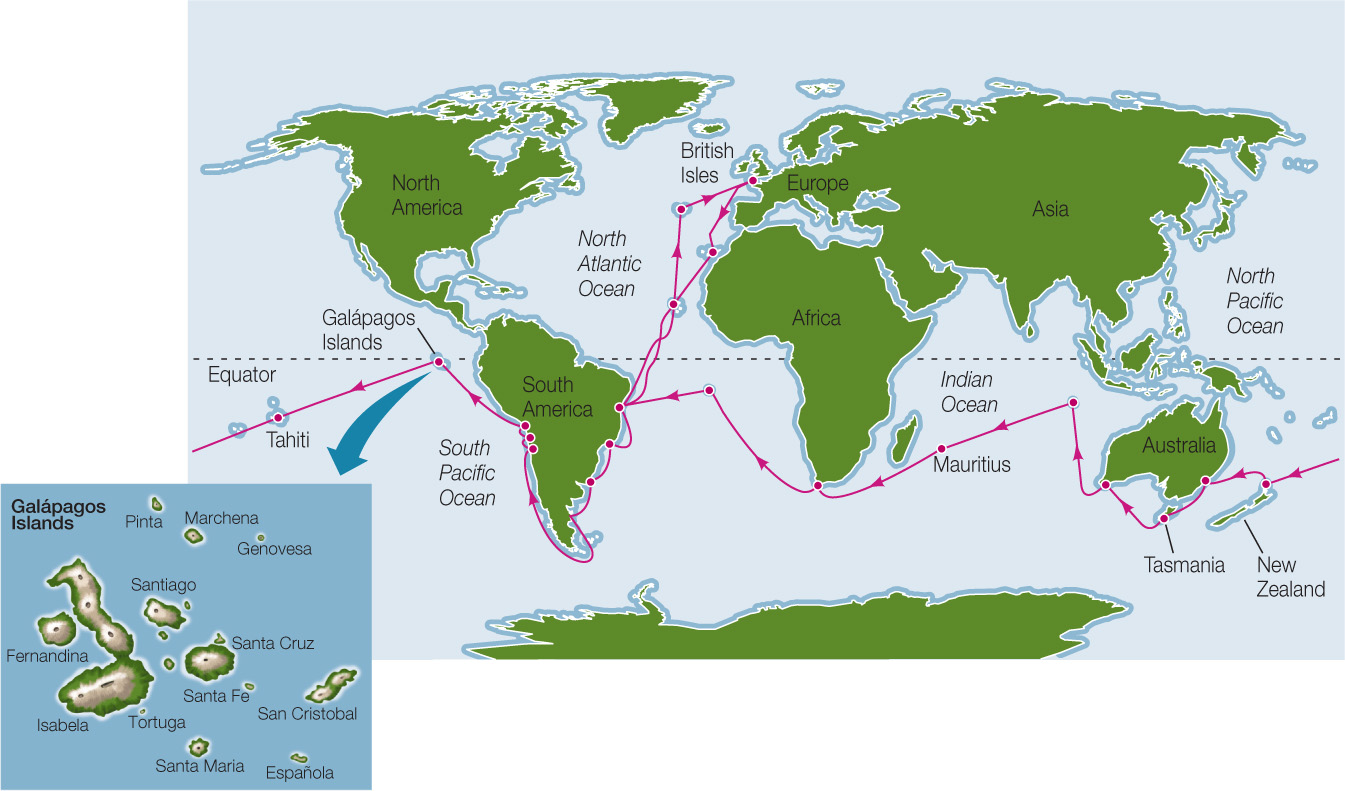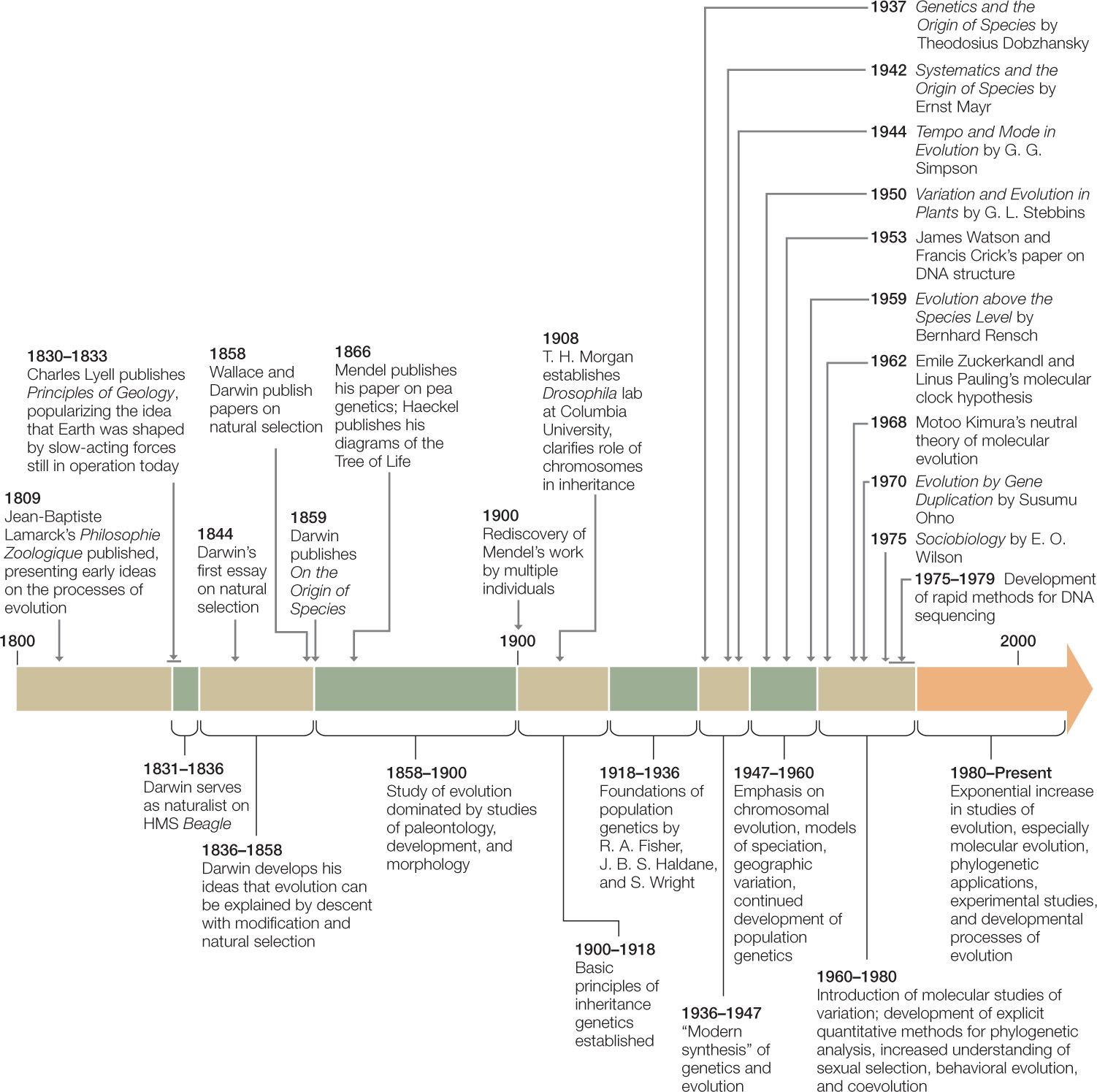CONCEPT15.1 Evolution Is Both Factual and the Basis of Broader Theory
All biological populations change in their genetic makeup over time. This change in the genetic composition of populations over time is called evolution. We can, and do, observe evolutionary change on a regular basis, both in laboratory experiments and in natural populations. We measure the rate at which new mutations arise, observe the spread of new genetic variants through a population, and see the effects of genetic change on the form and function of organisms. In the fossil record, we observe the long-term morphological changes (which are the result of underlying genetic changes) that have occurred among living organisms. These underlying changes in the genetic makeup of populations drive the origin and extinction of species and fuel the diversification of life.
In addition to observing and recording physical changes over evolutionary time, biologists have accumulated a large body of evidence about how these changes occur, and about what evolutionary changes have occurred in the past. The resulting understanding and application of the processes of evolutionary change to biological problems is known as evolutionary theory.
Evolutionary theory has many useful applications. We constantly apply it to the study and treatment of diseases. Evolutionary theory is critical to the development of better agricultural crops and practices, and to the development of industrial processes that produce new molecules with useful properties. At a more basic level, knowledge of evolutionary theory allows biologists to understand how life diversified. It also helps us make predictions about the biological world.
In everyday speech, people tend to use the word “theory” to mean an untested hypothesis, or even a guess. But evolutionary theory does not refer to any single hypothesis, and it certainly is not guesswork. The concept of evolutionary change among living organisms was present among a few scientists even before Charles Darwin so clearly described his observations, presented his conclusions, and articulated the premise of natural selection in his book On the Origin of Species. The rediscovery of Mendel’s experiments and the subsequent establishment of the principles of genetic inheritance early in the 1900s set the stage for vast amounts of research. By the end of the twentieth century, findings from many fields of biology firmly upheld Darwin’s basic premises about the common ancestry of life and the role of natural selection as an important process of evolution. Today a vast and rich array of geological, morphological, behavioral, and molecular data all support and expand the factual basis of evolution. Observations of fossils and natural populations are supported by experiments that demonstrate the basic operation of evolutionary processes.
When we refer to evolutionary theory, we are referring to our understanding of the processes that result in genetic changes in populations over time. We then apply that understanding to interpret the changes we observe in natural populations. We can directly observe the evolution of influenza viruses, but it is evolutionary theory that allows us to apply our observations to the task of developing more effective vaccines. Several processes of evolutionary change are recognized, and the scientific community is continually using evolutionary theory to expand its understanding of how and when these processes apply to particular biological problems.
Darwin and Wallace introduced the idea of evolution by natural selection
In the early 1800s, it was not yet evident to many people that populations of living organisms evolve. But several biologists had suggested that the species living on Earth had changed over time—that is, that evolution had taken place. Jean-Baptiste Lamarck, for one, presented strong evidence for the fact of evolution in 1809, but his ideas about how it occurred were not convincing. At that time, no one had yet envisioned a viable process for evolution.

In the 1820s, a young Charles Darwin became passionately interested in the subjects of geology (with its new sense of Earth’s great age) and natural history (the scientific study of how different organisms function and carry out their lives in nature). Despite these interests, he planned, at his father’s behest, to become a doctor. But surgery conducted without anesthesia nauseated Darwin, and he gave up medicine to study at Cambridge University for a career as a clergyman in the Church of England. Always more interested in science than in theology, he gravitated toward scientists on the faculty, especially the botanist John Henslow. In 1831, Henslow recommended Darwin for a position on HMS Beagle, a Royal Navy vessel that was preparing for a survey voyage around the world.

Whenever possible during the 5-year voyage (FIGURE 15.1), Darwin went ashore to study rocks and to observe and collect plants and animals. He noticed striking differences between the species he saw in South America and those of Europe. He observed that the species of the temperate regions of South America (Argentina and Chile) were more similar to those of tropical South America (Brazil) than they were to temperate European species. When he explored the islands of the Galápagos archipelago west of Ecuador, he noted that most of the animals were endemic to the islands (that is, unique and found nowhere else), although they were similar to animals found on the mainland of South America. Darwin also observed that the fauna of the Galápagos differed from island to island. He postulated that some animals had come to the archipelago from mainland South America and had subsequently undergone different changes on each of the islands. He wondered what might account for these changes.
300

When he returned to England in 1836, Darwin continued to ponder his observations. His thoughts were strongly influenced by the geologist Charles Lyell, who had recently popularized the idea that Earth had been shaped by slow-acting forces that are still at work today. Darwin reasoned that similar thinking could be applied to the living world. Within a decade, he had developed the framework of an explanatory theory for evolutionary change based on three major propositions:
- Species are not immutable; they change over time.
- Divergent species share a common ancestor and have diverged from one another gradually over time (a concept Darwin termed descent with modification).
- Changes in species over time can be explained by natural selection: the increased survival and reproduction of some individuals compared with others, based on differences in their traits.
The first of these propositions was not unique to Darwin; several earlier authors had argued for the fact of evolution. A more revolutionary idea was his second proposition, that divergent species are related to one another through common descent. But Darwin is probably best known for his third proposition, that of natural selection.
Darwin realized that many more individuals of most species are born than survive to reproduce. He also knew that, although offspring usually resemble their parents, offspring are not identical to one another or to either parent. Finally, he was well aware of the fact that human breeders of plants and animals often selected their breeding stock based on the occurrence of particular traits. Over time, this selection resulted in dramatic changes in the appearance of the descendants of those plants or animals. In natural populations, wouldn’t the individuals with the best chances of survival and reproduction be similarly “selected,” and thus pass their traits on to the next generation? Darwin’s simple but powerful idea was that nature did the selecting in natural populations on the basis of traits that resulted in greater survival and, eventually, greater likelihood of reproduction.
In 1844, Darwin wrote a long essay describing the role of natural selection as a process of evolution. But he was reluctant to publish it, preferring to assemble more evidence first. Darwin’s hand was forced in 1858, when he received a letter and manuscript from another traveling English naturalist, Alfred Russel Wallace, who was studying the plants and animals of the Malay Archipelago. Wallace asked Darwin to evaluate his manuscript, which included an explanation of natural selection almost identical to Darwin’s. Darwin was at first dismayed, believing Wallace to have preempted his idea. Parts of Darwin’s 1844 essay, together with Wallace’s manuscript, were presented to the Linnaean Society of London on July 1, 1858, thereby crediting both men for the idea of natural selection. Darwin then worked quickly to finish his own book, On the Origin of Species, which was published the following year.
301
Although Darwin and Wallace independently articulated the concept of natural selection, Darwin developed his ideas first. Furthermore, On the Origin of Species proved to be a stunning work of scholarship that provided exhaustive evidence from many fields supporting both the premise of evolution itself and the notion of natural selection as a process of evolution. Thus both concepts are more closely associated with Darwin than with Wallace.
The publication of On the Origin of Species in 1859 stirred considerable interest (and controversy) among scientists and the public alike. Scientists spent much of the rest of the nineteenth century amassing biological and paleontological data to test evolutionary ideas and document the history of life on Earth. By 1900, the fact of biological evolution (defined at that time as change in the physical characteristics of populations over time) was established beyond any reasonable doubt. But the genetic basis of evolutionary change was not yet understood.
Evolutionary theory has continued to develop over the past century
Shortly after 1900, several individuals rediscovered the work of Gregor Mendel (which had been published in 1866 but rarely read or cited), and the basic processes of genetic inheritance began to be unraveled. In the first decades of the twentieth century, Thomas Hunt Morgan’s studies on fruit flies led to his discovery of the role of chromosomes in inheritance. In the 1920s and early 1930s, the major principles of population genetics were established, the genetic basis of new variation (i.e., mutations) began to be understood, and processes of evolution such as genetic drift were described (see Concept 15.2). This work set the stage for a “modern synthesis” of genetics and evolution that took place over the period 1936–1947. Some of the major contributors to this synthesis and a few of their books are listed in FIGURE 15.2.

302
Although chromosomes were understood to be the basis of genetic transmission in eukaryotes by the early 1900s, their molecular structure remained a mystery until soon after the modern synthesis. Then, in 1953, Watson and Crick published their paper on the structure of DNA, opening the door to our current detailed understanding of molecular evolutionary processes. By the 1960s, biologists could study and document changes in allele frequencies in populations over time (see Concept 15.3). Most of this early work necessarily focused on variants of proteins that differed within and between populations and species. Even though the molecular structure of DNA was known, it was not yet practical to sequence long stretches of DNA. Nonetheless, many important advances occurred in evolutionary theory during this time (see Figure 15.2), and these advances were not focused solely on a genetic understanding of evolution. E. O. Wilson’s 1975 book Sociobiology, for example, invigorated studies of the evolution of behavior (a subject that had fascinated Darwin).
In the late 1970s, several techniques were developed that allowed the rapid sequencing of long stretches of DNA, which in turn allowed researchers to determine the amino acid sequences of proteins. This ability opened a new door for evolutionary biologists, who could now explore the structure of genes and proteins and document evolutionary changes within and between species in ways never before possible.
CHECKpointCONCEPT15.1
- How would you respond to someone who said that evolution was “just a theory”?
- Why do you think Darwin and Wallace formulated their ideas on natural selection at about the same time?
- Discuss the significance of each of the following scientific advances for evolutionary theory:
- Elucidation of the principles of chromosomal inheritance
- The discovery of DNA, its structure, and the universal genetic code
- Technology that allows us to sequence long segments of DNA
Natural selection is not the only process that drives evolution, although the importance of natural selection to evolution has been confirmed in many thousands of scientific studies. In the next section we’ll consider a more complete view of evolutionary processes and how they operate.